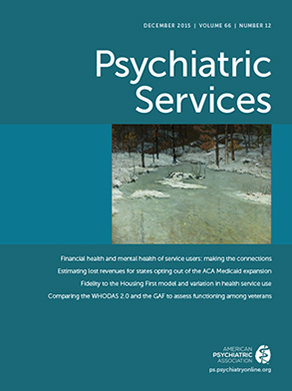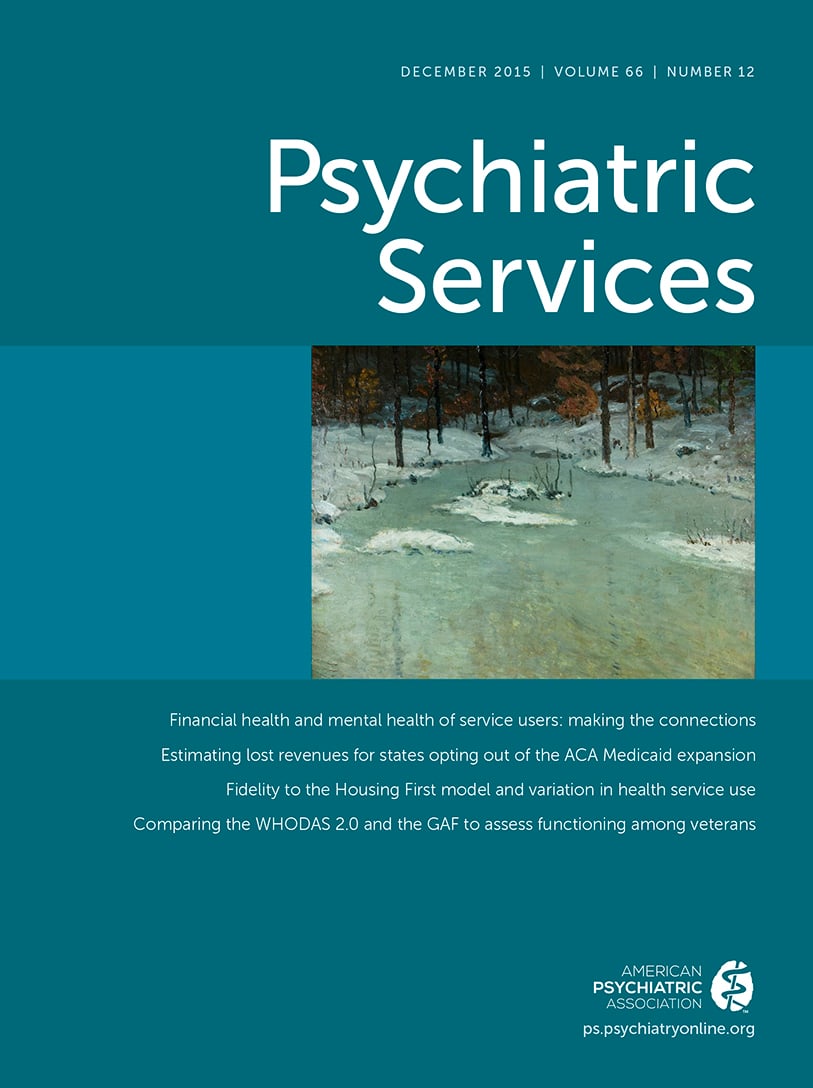Mental Health Service Use Among Adults With Suicide Ideation, Plans, or Attempts: Results From a National Survey
Abstract
Objective:
Methods:
Results:
Conclusions:
Methods
Participants and Procedures
Measures
Sociodemographic characteristics.
Suicide ideation, plans, and attempts.
Serious psychological distress.
General health.
Depression.
Mental health service use.
Data Analytic Strategy
Results
| Characteristic | Suicide ideation (N=2,126) | Suicide plan (N=690) | Suicide attempt (N=345) | ||||||
|---|---|---|---|---|---|---|---|---|---|
| N | Weighted % | 95% CI | N | Weighted % | 95% CI | N | Weighted % | 95% CI | |
| Type of treatment | |||||||||
| Any mental health careb | 959 | 52.4 | 48.6–56.3 | 376 | 58.4 | 51.9–64.7 | 184 | 53.9 | 44.6–63.1 |
| Inpatient | 175 | 7.4 | 5.7–9.5 | 112 | 17.8 | 13.1–23.7 | 84 | 26.3 | 18.3–36.3 |
| Outpatient | 595 | 32.8 | 29.2–36.7 | 265 | 44.5 | 37.9–51.3 | 129 | 43.1 | 34.1–52.5 |
| Prescription medication | 815 | 45.7 | 41.7–49.8 | 322 | 52.1 | 45.7–58.5 | 161 | 50.7 | 42.0–59.3 |
| Predisposing factor | |||||||||
| Age | |||||||||
| 18–25 | 1,370 | 27.3 | 24.7–30.1 | 447 | 31.7 | 27.5–36.2 | 232 | 31.6 | 25.9–37.9 |
| 26–34 | 242 | 17.3 | 14.6–20.4 | 80 | 20.6 | 14.9–27.8 | 39 | 20.4 | 13.3–30.0 |
| 35–49 | 324 | 24.6 | 21.3–28.2 | 119 | 28.4 | 23.7–33.6 | 55 | 27.9 | 20.5–36.8 |
| ≥50 | 190 | 30.8 | 26.3–35.7 | 44 | 19.4 | 13.8–26.5 | 19 | 20.1 | 12.0–31.7 |
| Female | 1,216 | 53.1 | 49.3–56.9 | 406 | 57.6 | 51.9–63.1 | 206 | 60.0 | 52.1–67.4 |
| Non-Hispanic white | 1,363 | 69.1 | 65.5–72.5 | 453 | 69.5 | 63.8–74.7 | 191 | 57.8 | 47.2–67.8 |
| Veteran | 85 | 7.3 | 4.7–11.3 | 31 | 7.3 | 4.7–11.1 | 14 | 5.9 | 2.8–12.0 |
| Enabling factor | |||||||||
| Married | 361 | 33.9 | 29.7–38.4 | 106 | 25.2 | 19.5–32.1 | 37 | 21.3 | 13.8–31.2 |
| Poverty (<100% federal poverty level) | 648 | 23.7 | 21.3–26.3 | 233 | 31.7 | 26.5–37.4 | 149 | 43.2 | 33.7–53.3 |
| Health insurance (any type) | 1,612 | 77.0 | 74.4–79.4 | 508 | 69.8 | 63.6–75.3 | 243 | 66.1 | 56.5–74.5 |
| Need factor | |||||||||
| Serious psychological distress (past year) | 1,461 | 60.0 | 55.7–64.1 | 555 | 77.6 | 71.4–82.8 | 278 | 73.7 | 64.1–81.4 |
| General health (past year)c | |||||||||
| Excellent | 304 | 14.8 | 11.9–18.3 | 73 | 10.5 | 7.7–14.1 | 40 | 13.4 | 8.1–21.2 |
| Very good | 710 | 27.3 | 24.1–30.7 | 230 | 31.9 | 26.2–38.1 | 87 | 23.6 | 16.4–32.8 |
| Good | 702 | 33.8 | 30.0–37.8 | 216 | 27.4 | 21.7–33.9 | 118 | 31.2 | 22.5–41.4 |
| Fair or poor | 409 | 24.1 | 20.8–27.6 | 170 | 30.1 | 24.4–36.6 | 100 | 31.8 | 23.2–42.0 |
| Major depressive episode (past year) | 1,025 | 47.9 | 43.7–52.1 | 413 | 60.1 | 54.1–65.9 | 186 | 50.2 | 41.0–59.4 |
| Characteristic | OR | 95% CI | p |
|---|---|---|---|
| Predisposing factor | |||
| Age (reference: 18–25) | |||
| 26–34 | 1.47 | .97–2.24 | .071 |
| 35–49 | 2.56 | 1.72–3.81 | <.001 |
| ≥50 | 2.55 | 1.73–3.75 | <.001 |
| Female (reference: male) | 1.60 | 1.08–2.35 | .019 |
| Non-Hispanic white (reference: black, Hispanic or other) | 2.11 | 1.34–3.34 | .002 |
| Veteran (reference: nonveteran) | 1.77 | .77–4.09 | .178 |
| Enabling factor | |||
| Married (reference: never married, divorced or separated, or widowed) | 1.40 | .92–2.11 | .111 |
| Poverty (reference: >100% federal poverty level) | .93 | .65–1.31 | .660 |
| Health insurance (reference: none) | 1.83 | 1.31–2.55 | .001 |
| Need factor | |||
| Serious psychological distress (reference: none) | 2.22 | 1.49–3.31 | <.001 |
| Fair or poor general health (reference: excellent, very good, or good) | 1.90 | 1.30–2.79 | .001 |
| Major depressive episode (reference: no past-year major depressive episode) | 3.14 | 2.16–4.54 | <.001 |
| Characteristic | OR | 95% CI | p |
|---|---|---|---|
| Predisposing factor | |||
| Age (reference: 18–25) | |||
| 26–34 | 1.60 | .72–3.53 | .240 |
| 35–49 | 2.78 | 1.56–4.97 | .001 |
| ≥50 | 1.50 | .64–3.54 | .346 |
| Female (reference: male) | 1.05 | .64–1.73 | .838 |
| Non-Hispanic white (reference: black, Hispanic, or other) | 2.39 | 1.37–4.17 | .003 |
| Veteran (reference: nonveteran) | 1.01 | .43–2.33 | .990 |
| Enabling factor | |||
| Married (reference: never married, divorced or separated, or widowed) | 1.84 | .92–3.70 | .085 |
| Poverty (reference: >100% federal poverty level) | 1.09 | .63–1.89 | .744 |
| Health insurance (reference: none) | 1.36 | .76–2.43 | .302 |
| Need factor | |||
| Serious psychological distress (reference: none) | 4.07 | 2.10–7.88 | <.001 |
| Fair or poor general health (reference: excellent, very good, or good) | 1.72 | 1.08–2.73 | .023 |
| Major depressive episode (reference: no past-year major depressive episode) | 4.97 | 2.95–8.38 | <.001 |
| Characteristic | OR | 95% CI | p |
|---|---|---|---|
| Predisposing factor | |||
| Age (reference: 18–25) | |||
| 26–34 | 1.74 | .57–5.34 | .323 |
| 35–49 | 2.43 | 1.12–5.24 | .025 |
| ≥50 | .91 | .29–2.90 | .872 |
| Female (reference: male) | 1.08 | .48–2.39 | .856 |
| Non-Hispanic white (reference: black, Hispanic, or other) | 2.95 | 1.17–7.43 | .023 |
| Veteran (reference: nonveteran) | 1.03 | .19–5.67 | .969 |
| Enabling factor | |||
| Married (reference: never married, divorced or separated, or widowed) | 1.50 | .53–4.28 | .438 |
| Poverty (reference: >100% federal poverty level) | 1.03 | .45–2.34 | .943 |
| Health insurance (reference: none) | 1.25 | .53–2.94 | .600 |
| Need factor | |||
| Serious psychological distress (reference: none) | 3.35 | 1.25–8.98 | .017 |
| Fair or poor general health (reference: excellent, very good, or good) | 1.79 | .90–3.58 | .095 |
| Major depressive episode (reference: no past-year major depressive episode) | 5.77 | 2.60–12.81 | <.001 |
| Characteristic | OR | 95% CI | p |
|---|---|---|---|
| Predisposing factor | |||
| Age (reference: 18–25) | |||
| 26–34 | 1.30 | 1.12–1.49 | .001 |
| 35–49 | 1.45 | 1.31–1.61 | <.001 |
| ≥50 | 1.34 | 1.18–1.53 | <.001 |
| Female (reference: male) | 2.14 | 1.90–2.42 | <.001 |
| Non-Hispanic white (reference: black, Hispanic, or other) | 2.22 | 1.93–2.54 | <.001 |
| Veteran (reference: nonveteran) | .75 | .60–.94 | .013 |
| Enabling factor | |||
| Married (reference: never married, divorced or separated, or widowed) | .76 | .69–.84 | <.001 |
| Poverty (reference: >100% federal poverty level) | 1.21 | 1.04–1.42 | .014 |
| Health insurance (reference: none) | 1.73 | 1.46–2.05 | <.001 |
| Need factor | |||
| Serious psychological distress (reference: none) | 6.78 | 5.82–7.90 | <.001 |
| Fair or poor general health (reference: excellent, very good, or good) | 1.82 | 1.57–2.11 | <.001 |
| Major depressive episode (reference: no past-year major depressive episode) | 10.10 | 8.47–12.05 | <.001 |
Past-Year Suicide Ideation
Past-Year Suicide Plan
Past-Year Suicide Attempt
Differences Between Suicidal and Nonsuicidal Individuals
Discussion
Conclusions
Footnote
References
Information & Authors
Information
Published In

Cover: Winter Woods and Brook, by John Joseph Enneking, circa 1906. Oil on board. Gift of Mr. and Mrs. Stanton Davis (Elisabeth Kaiser, class of 1932). Davis Museum, Wellesley College. Photo credit: Davis Museum/Art Resource, New York City.
History
Authors
Competing Interests
Funding Information
Metrics & Citations
Metrics
Citations
Export Citations
If you have the appropriate software installed, you can download article citation data to the citation manager of your choice. Simply select your manager software from the list below and click Download.
For more information or tips please see 'Downloading to a citation manager' in the Help menu.
View Options
View options
PDF/EPUB
View PDF/EPUBLogin options
Already a subscriber? Access your subscription through your login credentials or your institution for full access to this article.
Personal login Institutional Login Open Athens loginNot a subscriber?
PsychiatryOnline subscription options offer access to the DSM-5-TR® library, books, journals, CME, and patient resources. This all-in-one virtual library provides psychiatrists and mental health professionals with key resources for diagnosis, treatment, research, and professional development.
Need more help? PsychiatryOnline Customer Service may be reached by emailing [email protected] or by calling 800-368-5777 (in the U.S.) or 703-907-7322 (outside the U.S.).
